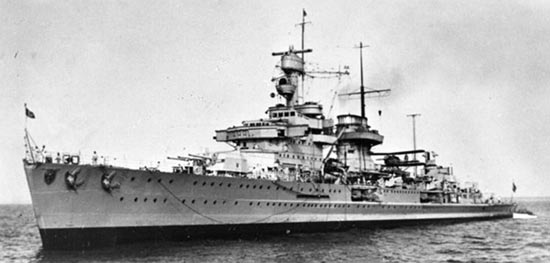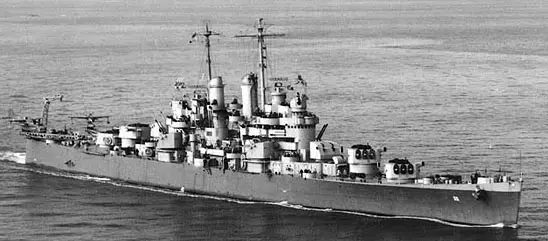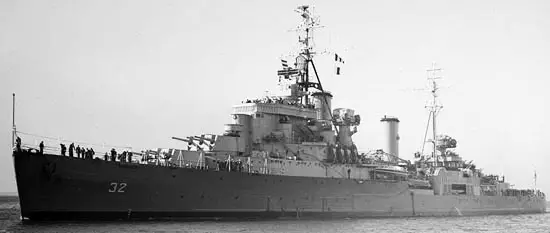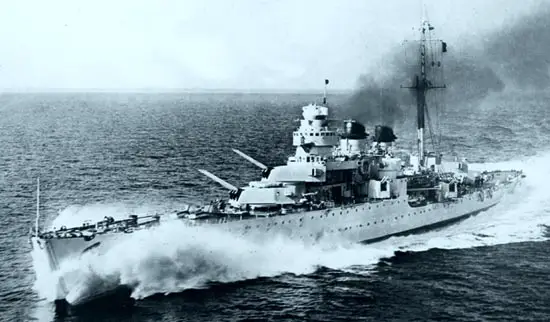The Best Light Cruisers of World War II By Chuck Hawks After the adoption of the Washington Naval Treaty of 1922, light cruisers (CL) with 6" guns inherited the roles of the earlier protected cruiser, which were to scout for the battle fleet, patrol the seas, enforce blockades, shadow enemy capital ships, show the flag on distant stations and enforce colonial rule. Light cruisers were able to bring greater firepower to bear than any of the vessels they were likely to encounter on distant stations (pirates, armed merchant cruisers, gunboats, destroyers, torpedo boats and the like). As the 20th Century progressed and ever more capable scout and patrol aircraft entered service, independent cruiser operations decreased in importance and light cruisers increasingly assumed the role of screening capital ships (especially aircraft carriers) and vital, especially troop carrying, convoys against enemy air and surface threats. The Washington Treaty established 10,000 tons standard displacement as the maximum size for all cruisers and 6.1" (155mm) main battery guns as the maximum for light cruisers and 8" (203mm) guns as the maximum for heavy cruisers (CA). Thus, the terms "light" and "heavy" pertained to main battery gun armament, rather than the size/displacement of the ship. Heavy cruisers essentially replaced armored cruisers in the major powers' fleets and light cruisers were generally viewed as smaller, less expensive and less heavily armored than heavy cruisers. However, as time went by, the difference in size between the largest of the two types essentially vanished in the USN, both types being designed to the 10,000 treaty limit. The largest Royal Navy cruisers, whether heavy or light, also displaced around 10,000 tons standard. Perhaps the ultimate example of this interchangeability of light and heavy cruiser design was the Japanese Mogami class, which were commissioned as light cruisers armed with 15-6.1" guns in five triple turrets in order to conform to the Washington Naval Treaty. When war became imminent, they were rearmed as heavy cruisers simply by exchanging the triple 6" turrets for twin 8" turrets, which by design shared the same size turret rings. The Mogami's were, in fact, among the most powerful and capable of all WW II heavy cruisers and graphically demonstrated that there was no longer any practical difference, in terms of hull size or displacement, between light and heavy cruisers. As relatively expensive ships intended to be capable of independent operations, cruisers were typically built to heavier and more durable standards, with heavier scantlings, machinery and double bottoms, than large destroyer (DL) types, which were nipping at the heels of the smaller light cruisers in terms of size and firepower. Long range was important to cruiser operations and this greater range also differentiates cruisers from destroyers. In addition, unlike most destroyer types, the vitals of light cruisers were usually armored to protect against destroyer caliber shells and, in some cases, against 6" shellfire. The need for greater longevity, durability, armor, fuel and stores naturally made light cruisers bigger than large destroyers. In the 1930's, a theory arose that a big cruiser armed with a large number of 6" guns (usually 12 to 15) might overwhelm a heavy cruiser armed with fewer and slower firing 8" guns at short to medium range. What followed was a mini naval arms race centered on the 6" gun cruiser. There was nothing "light" about these powerful vessels. In the U.S., the Brooklyn class (CL, 15-6" guns) and Wichita (CA, 9-8" guns), commissioned in 1938-1939, were built on the same hulls with a similar layout. During World War II, the need for smaller light cruisers arose. This resulted in the the Italian Capitani Romani class, the Royal Navy's Dido and Bellona classes and the USN's Atlanta class. These small cruisers were armed, respectively, with 5.31" (135mm), 5.25" and 5" main battery guns and were designed to counter enemy aircraft and large destroyers. In this article, we will examine the ultimate light cruisers of the major naval powers: Germany, Japan, France, the United States, Great Britain and Italy. The ships' specifications that follow were taken from Conway's All the World's Fighting Ships, 1922-1946. Germany  The Nurnberg, commissioned in 1935, was the last light cruiser completed for the Reichsmarine. Six scout cruisers of the "M" class (7800 tons, 8-150mm guns) were proposed and construction was started on three of these ships, but the outbreak of war diverted the necessary strategic materials to other purposes and they were never completed. After WW I, Germany had no distant colonial empire to protect and the German navy concentrated on relatively short range and lightly built cruisers primarily suitable for Baltic and North Sea operations. German light cruisers were armed with eight or nine 5.9" (150mm) main battery guns and had standard displacements of less than 7000 tons. Only six German light cruisers were completed between 1925 and 1945 and none of them had particularly inspiring war records. By the middle of the war, the surviving light cruisers were used mainly as cadet training vessels. Late in the war, they provided fire support along the Baltic coast against advancing Red Army troops. Nurnberg and her half sister Leipzig make an interesting comparison to Allied light cruisers. Their hulls were extensively electrically welded, a ship construction technique pioneered in Germany, and they were powered by a combination of steam turbines and diesel engines to increase their range. They had three propeller shafts, the outer shafts being powered by geared steam turbines and the center shaft by four MAN diesel engines. When cruising, the diesels would supply all the motivating power, the outer propellers merely turned at idling speed by electric motors to reduce their drag. For high-speed runs, all three shafts would be driven. The center propeller had variable pitch blades for maximum efficiency. The main battery guns were mounted in three triple turrets, situated in the A, X and Y positions. This meant that six guns could fire directly astern and only three guns forward, the reverse of most warship layouts. This made them well suited for engaging pursuing enemy cruisers while retreating from a superior enemy force. (The French navy, considered to be Germany's most likely potential opponent, was substantially larger than the German navy in the 1930's.) The main battery turrets allowed 40-degrees of elevation. A heavy torpedo battery, with six tubes in two triple mounts per side, was also useful for dissuading pursuit from astern. Here are the specifications for Nurnberg.
Nurnberg was torpedoed by a British submarine in 1939 during a mine laying operation in the North Sea and was being repaired while most of the Reichsmarine was supporting the invasion of Norway, the one great German naval victory of the war. After completing repairs, she served as a cadet training ship, alternating for a time as part of the fleet in Norwegian waters. None of the German light cruisers had illustrious careers, but Nurnberg managed to survive the war. After the war, she was ceded to the USSR as reparations and served the Red Navy's Baltic Fleet as the Admiral Makarov into the middle 1950's. Japan  Pre-war Japanese heavy cruisers were generally designed to achieve qualitative superiority over those of the UK and USA, since they knew they could not match those powers in numbers. A Pacific Ocean navy, the IJN preferred heavy cruisers to light cruisers, generally designing and using their light cruisers to serve as scouts or leaders of destroyer, submarine or escort flotillas. This required smaller light cruisers than those favored by most other navies. The Agano class of four ships was probably the best balanced and most successful of the Japanese light cruisers. They were relatively small cruisers, at 6,652 tons standard displacement, and carried 6-6" main battery guns in twin turrets (two forward and one aft). They also carried eight centerline (2x4) launching tubes for the famed 24" Long Lance torpedoes, the best anti-ship torpedo of the war, and an exceptionally heavy battery of AA guns. Unlike most light cruisers, they carried depth charges to attack submarines. Here are their basic specifications.
Like practically all WW II cruisers, the light AA armament was increased with experience. The number of light 25mm AA guns was increased to 46 by January 1944, to 52 by March 1944 and to 61 by July 1944. Three of these ships (Agano, Noshiro and Yahagi) were lost in action, while the fourth (Sakawa) survived the war to be expended in the Bikini atom bomb test. Agano was sunk by a U.S. submarine, while her two sisters were lost to U.S.N. carrier planes. Yahagi was sunk along with the super battleship Yamato on the last sortie by major IJN warships; U.S. flyers stated that she was almost as much trouble to sink as the battleship! Visually, these were flush deck, low silhouette ships with a tower bridge and a single smoke stack. They presented a long, sleek appearance and, from what I have read, were good ships. Their main battery of only 6-6" guns would have put them at a disadvantage in a daylight gun battle against the other cruisers included in this article. However, their heavy, long range torpedo battery served as a potential equalizer in night engagements. France  The La Galissonniere class of six cruisers represented the best French light cruiser design. They were medium size cruisers armed with 9-6" guns in three triple turrets, two forward and one aft. The 6" guns fired a 54.3kg (120 lb.) shell a distance of 21,500 meters (23,292 yards). They were, by all reports, seaworthy ships with efficient machinery. Designed for a maximum speed of 32.5 knots, they exceeded 35 knots on trials at over 100,000 shp. Their range was 7000nm at 12 knots, 5500nm at 18 knots and 1650nm at 34 knots.
The light AA armament of the surviving ships was progressively increased as the war continued, ultimately reaching 24-40mm (6x4) and 16-20mm (16x1) guns on the three ships refitted in the USA during the war for use by the Free French navy (Gloire, Montcalm and Georges Leygues). By 1945, at a full load displacement of 10,850 tons, they could still achieve a top speed of 32 knots. The Vichy French cruisers La Galissonniere, Jean De Vienne and Marseillaise refused to join the Allies after the fall of France and were scuttled at Toulon in 1942 to avoid falling into German hands. Gloire, Montcalm and Georges Leygues served with the Free French navy during the latter part of the war and survived to become part of the post-war French navy. Montcalm served as an accommodation ship from 1958 to 1970, when she was broken-up, while her two sisters were sold to the breakers in 1958-1959. United States  From at least the mid-1920's onward, the USN favored heavy cruisers over light cruisers. This is evident by the disparity in the number of classes of each type built through 1945: 6-CA and 3-CL, including the small anti-aircraft light cruisers (CLAA) armed with 5" DP guns of the Atlanta class. The only American 6" cruiser classes were the Brooklyn's (9767 tons, 15-6" guns, 1938-1939) and the Cleveland's (11,744 tons, 12-6" guns, 1942-1946). It is the latter class that we will deal with here, as they benefited from wartime experience. The Cleveland class was the most numerous of all WW II light cruisers, with 29 uints completed. Designed with Pacific Ocean operations in mind, they had a very long cruising range. There was considerable variation in the details of the various units of the class, as they entered service over a five-year period (1942-1946) and the later ships were modified to benefit from experience gained with the earlier ships. Like all WW II U.S.N cruisers, the Cleveland's were not equipped with torpedo batteries, an oversight that was to cost the Navy dearly in numerous night battles with Japanese warships. Here are the specifications for the USS Biloxi, which was commissioned in 1943
The U.S. was the only major power that continued to build very large light cruisers throughout the war; all the other powers reverted to building more modest light cruisers. The Cleveland's were very heavily armed and armored against 6" (105 pound) shells striking at a 90-degree angle between 9400-21,700 yards. This, along with constantly increasing electronic, ECM and radar gear, created problems with top weight and stability, which by 1945 had become severe. Nine Cleveland class hulls were converted into light carriers during construction in 1942 and these ships served effectively during the war. None of the ships completed as cruisers were sunk by enemy action and most were retained into the 1960's. Six ships were rebuilt as guided missile cruisers long after the war and these served into the 1970's, the last (Oklahoma City) was stricken from the Navy list in 1979. The Cleveland's were the most powerful light cruisers of the war in either an AA or surface engagement, but perhaps not the best all-around ships. Great Britain  The UK built both small and large cruisers during WW II. In fact, between 1900 and 1939, when the war began, the UK had built more cruisers than any other country, so they knew a thing or two about cruiser design. The Swiftsure class (Swiftsure and Ontario) were middle size cruisers, mounting 9-6" guns in three triple turrets. This was one triple turret less than the previous Fiji class, but the AA armament was increased. Aircraft had become a greater danger than enemy surface ships by the time these cruisers were launched in 1943. Here are Swiftsure's initial specifications.
Upon completion in 1944, one of the two Swiftsure class was transferred to the Canadian Navy and named Ontario. As with all cruisers during WW II, the light AA armament was progressively increased on these ships. Swiftsure first received 22-20mm light AA; in 1945 these were removed and replaced by 13-40mm single mounts. Ontario was similarly upgraded, but retained six of her 20mm guns, as well. The Swiftsure class was not as well armed as the American Cleveland's, but they were more seaworthy, carried less top weight and were probably better overall ships. More importantly, they were generally more capable than the Axis light cruisers, with the possible exception of the Italian Abruzzi class, which had been neutralized by the time the Swiftsure's went into service. Neither ship was sunk in action and both served the Royal Navy post-war. Ontario was sent to the breakers in 1960, followed by Swiftsure in 1962. Italy  The two ships of the Abruzzi class represented the newest Italian 6" gun cruisers to serve in WW II. The follow-on Costanzo Ciano class (two ships), ordered in 1939-40, was cancelled before being laid down. Since the end of the First World War, Italian light cruisers had been gradually transitioning from very fast, but not very capable, destroyer killers into good all-around cruisers. The Luigi Di Savoia Duca Degli Abruzzi and Giuseppe Garibaldi were the final step in that evolution. At a standard displacement of 9440 tons, they were big enough to carry 10-6" guns in four turrets, a twin turret in the "B" and "X" positions superfiring over a triple turret in the "A" and "Y" positions. They also were armored to contemporary cruiser standards, had a good AA battery and adequate range for Mediterranean (or even Atlantic) operations. Here are the specifications for Abruzzi.
These were attractive, well-balanced, twin funnel ships with a long forecastle. Their main battery guns could elevate to 45-degrees and lob a 110 pound shell some 27,000 yards. Rate of fire was 4-5 rounds per minute. Maximum sea speed in wartime conditions was about 31 knots. Seldom given the credit due outside of Italy, the Abruzzi class were possibly the finest light cruisers to serve in the Second World War. They lacked fire control radar and therefore were at a great disadvantage against Allied cruisers at night or in conditions of low visibility, but had Italy won the war, this would have been corrected. Both ships were surrendered intact to the Allies when Italy changed sides in the war. They were returned to the Italian navy after the war and became the backbone of the new Italian fleet. Abruzzi was stricken in 1961, but Giuseppe Garibaldi was converted into a guided missile cruiser during 1957-1961 and served until 1972. |